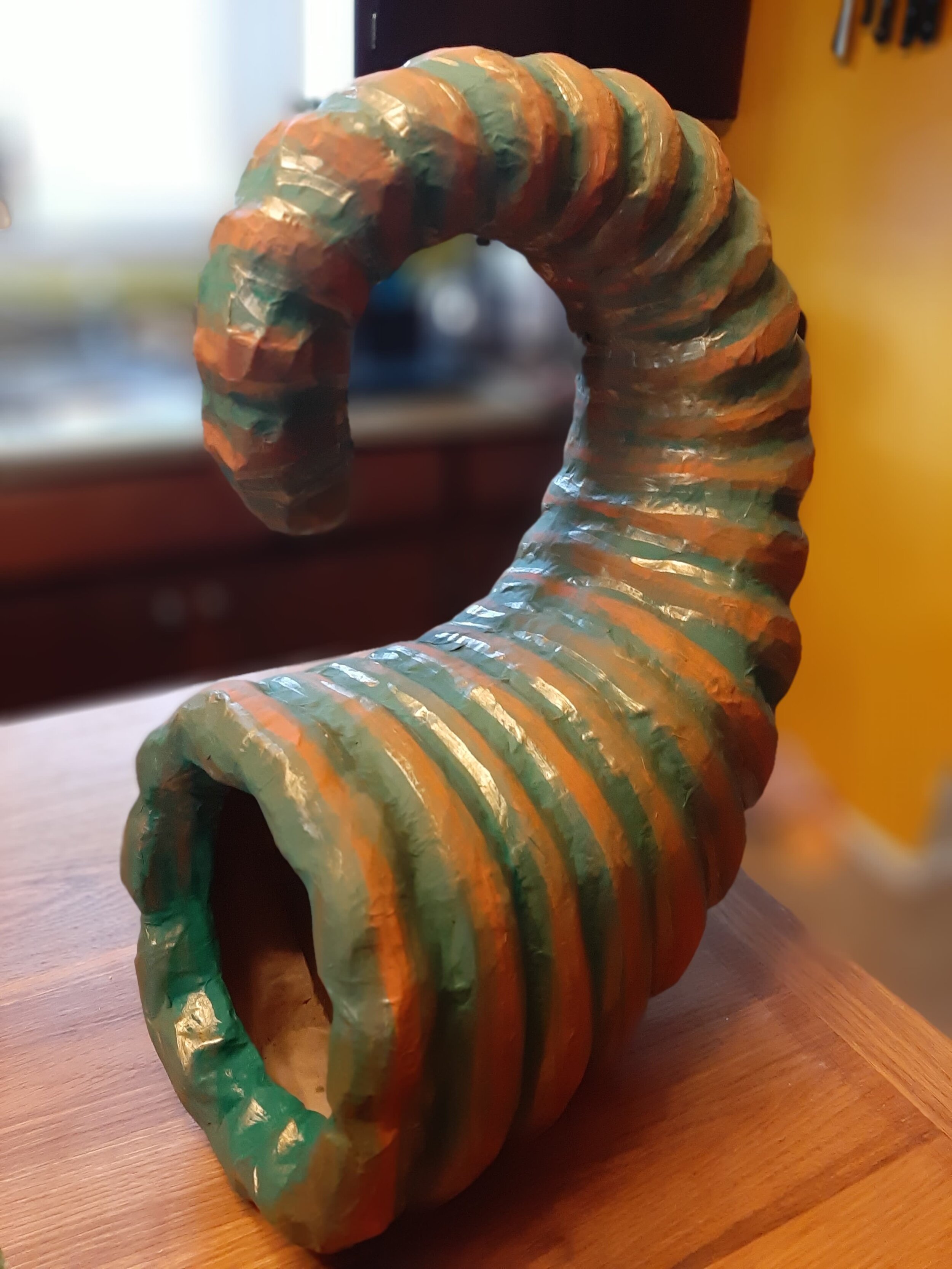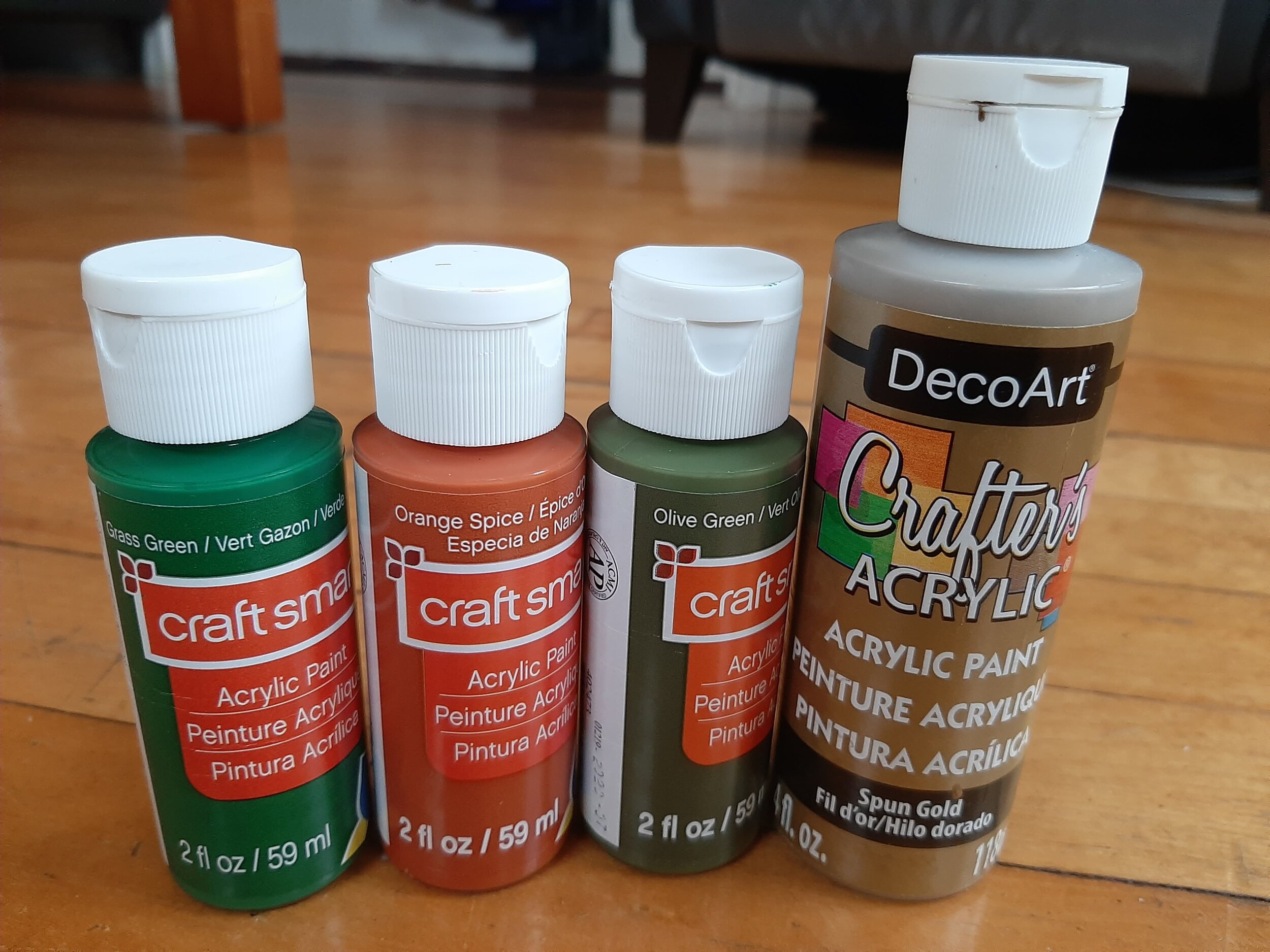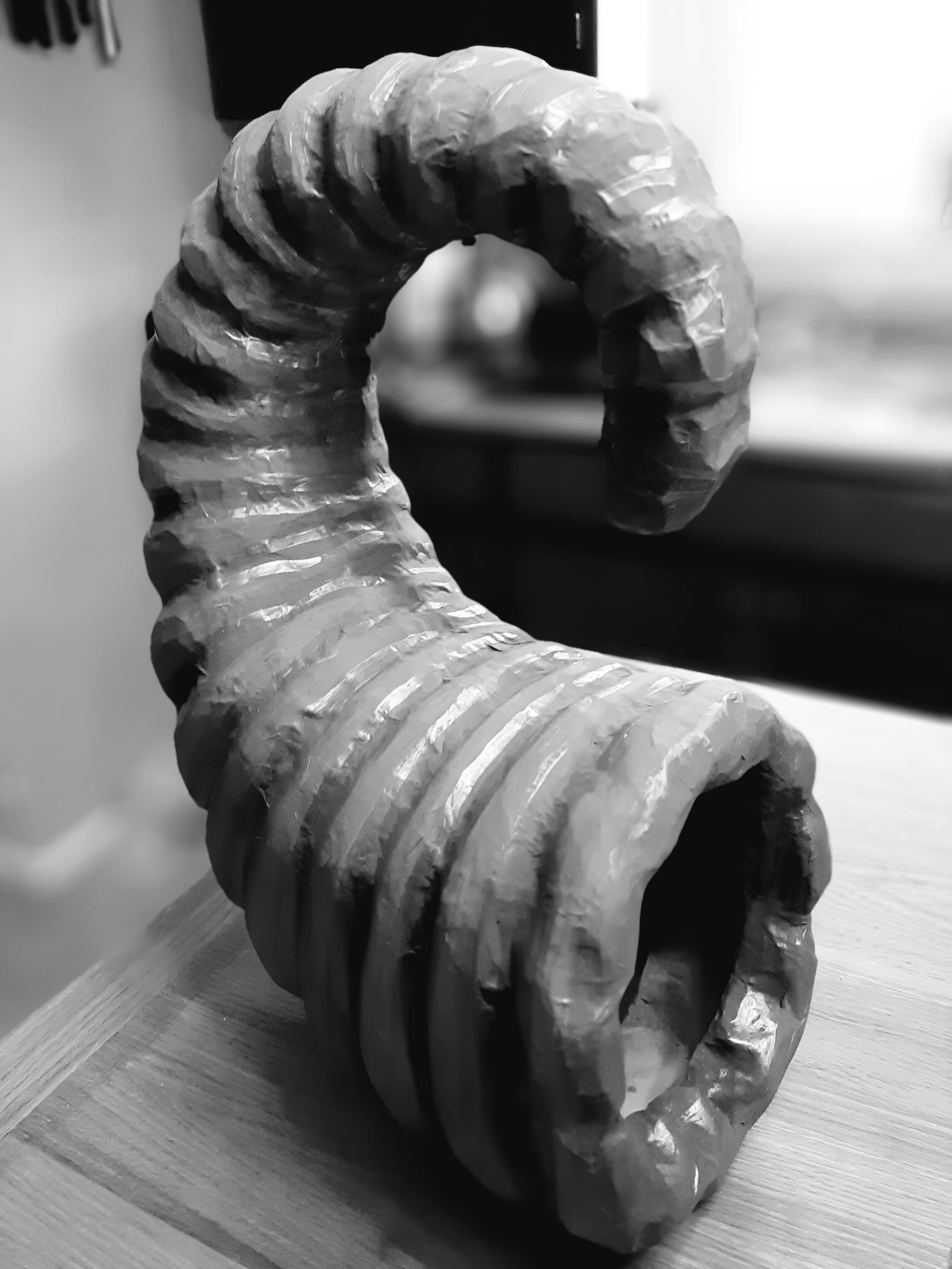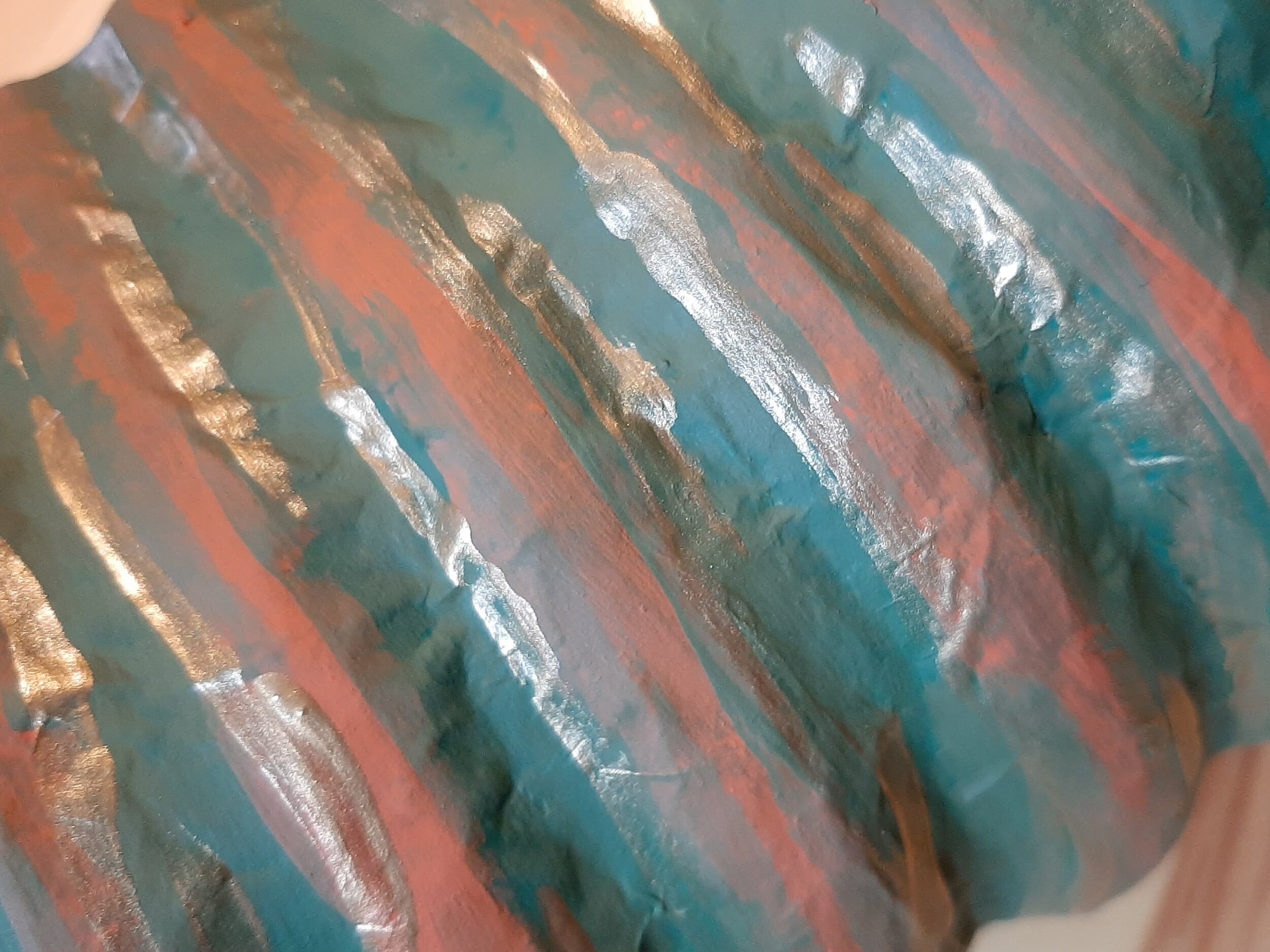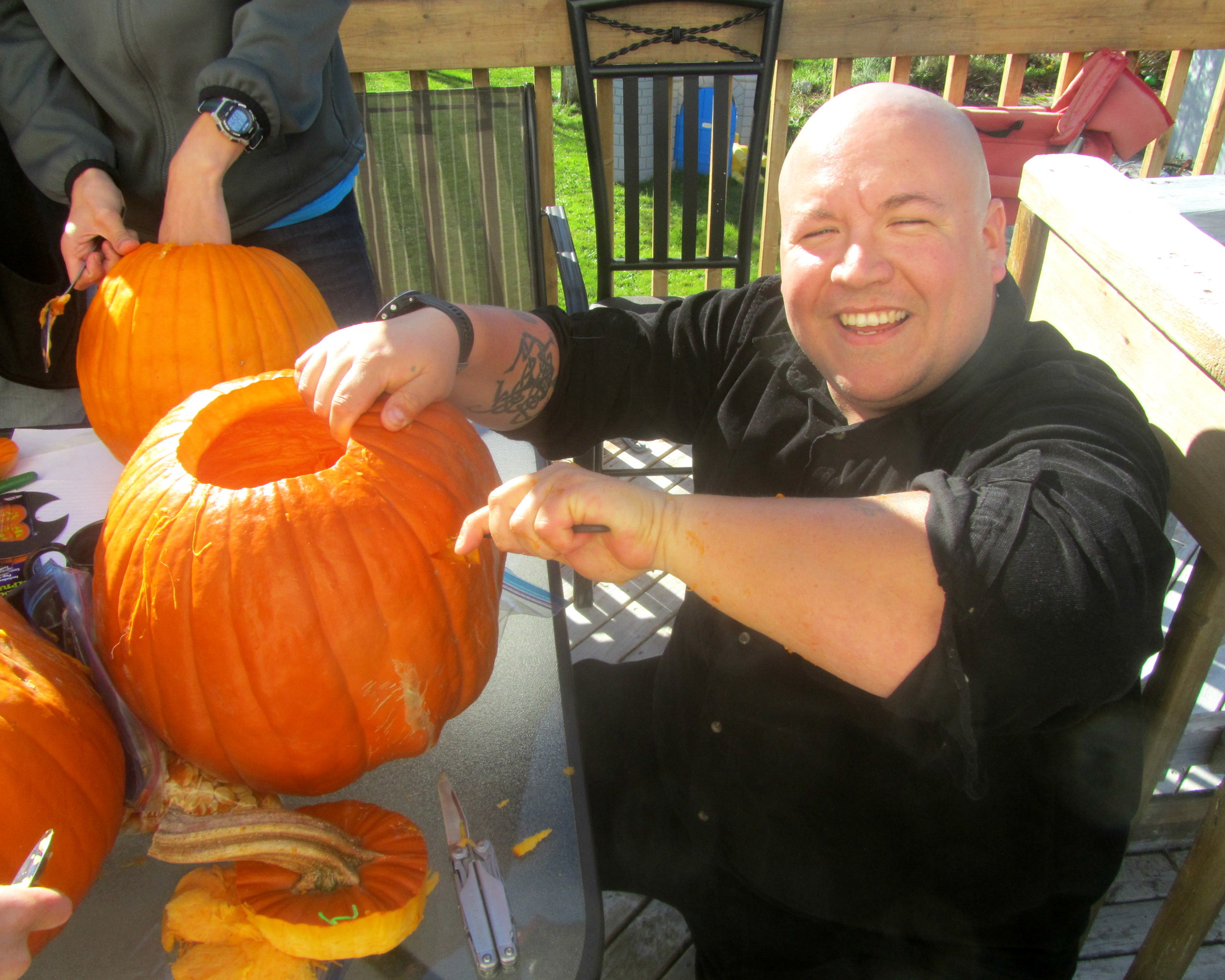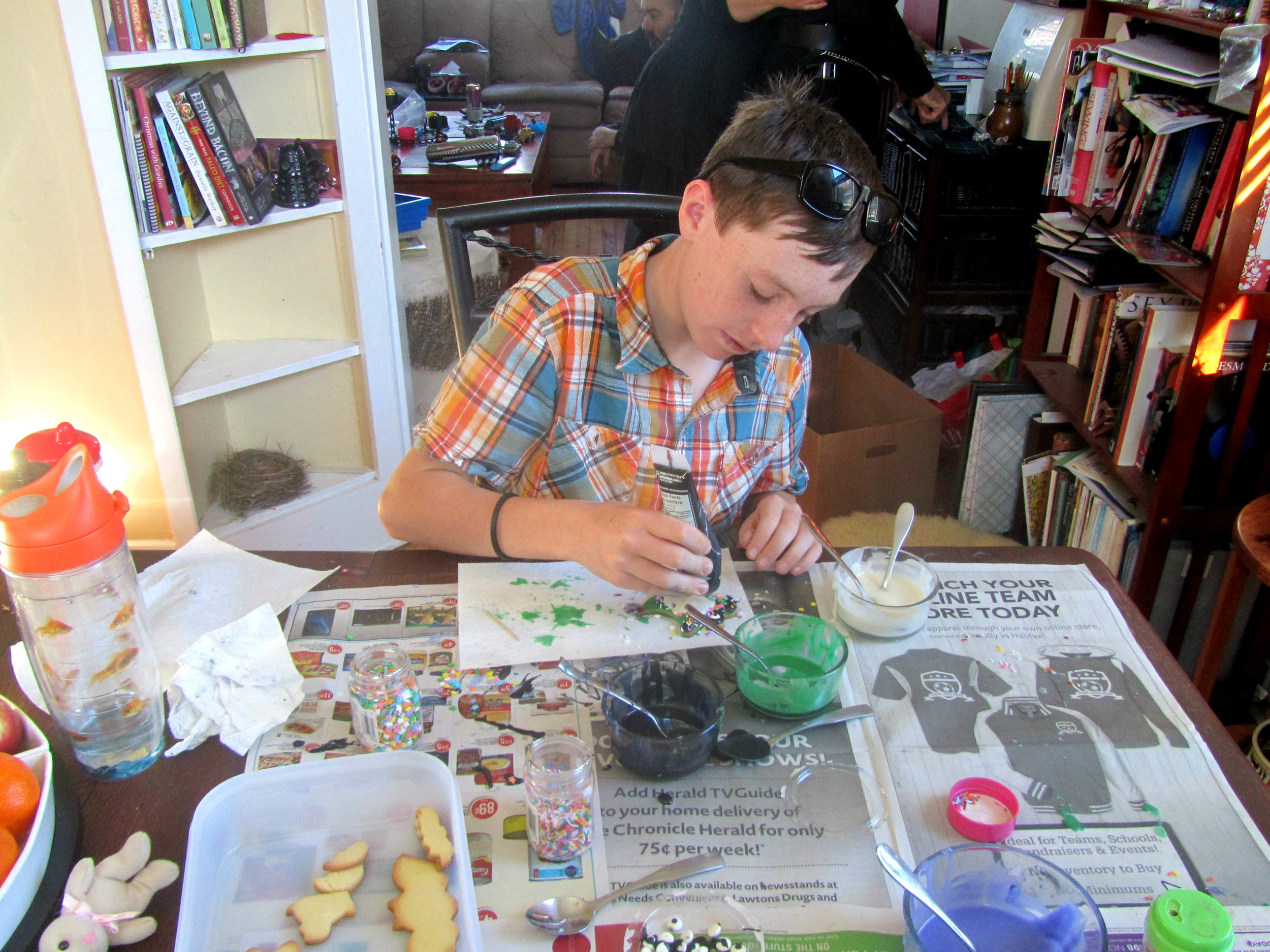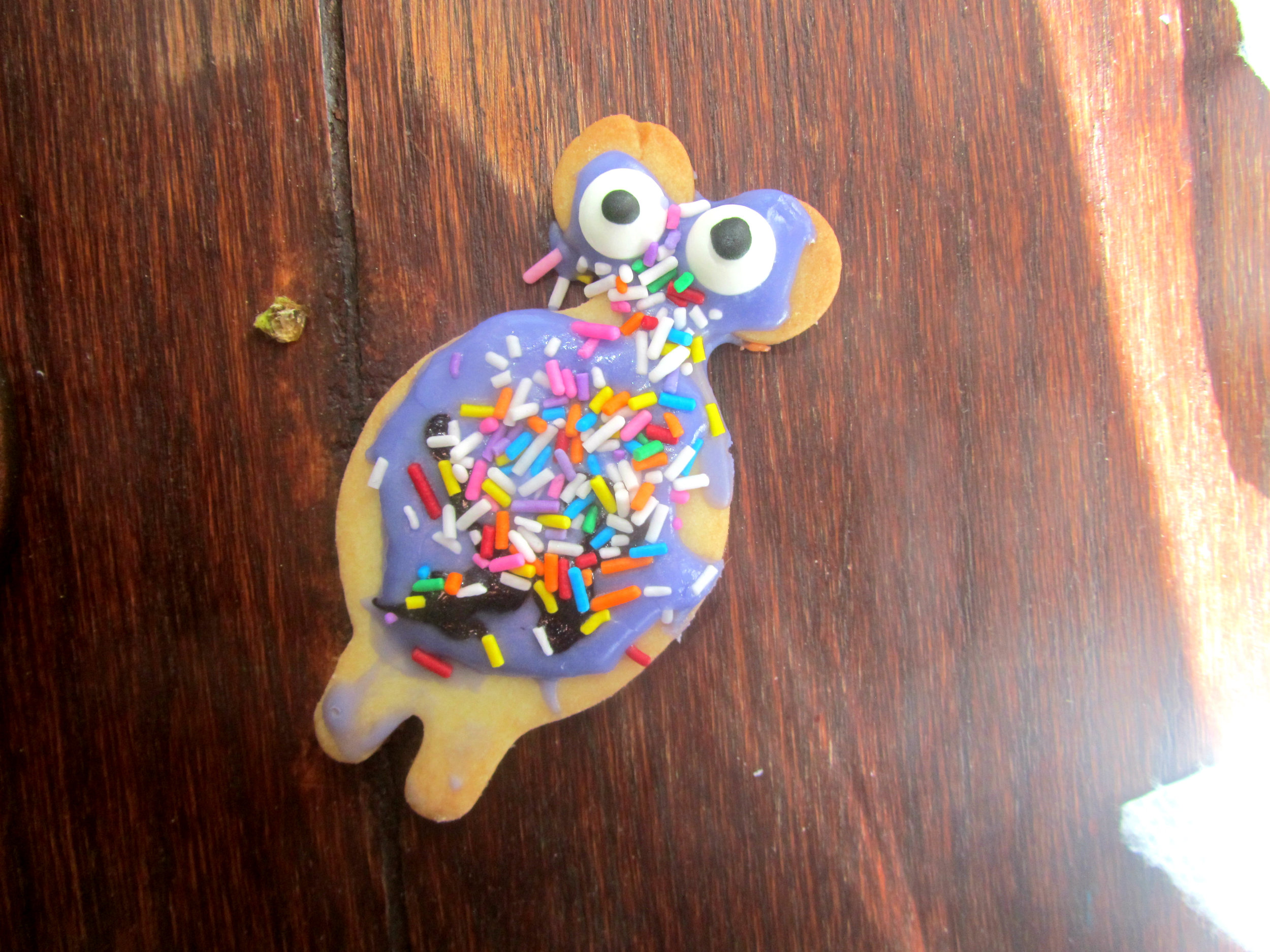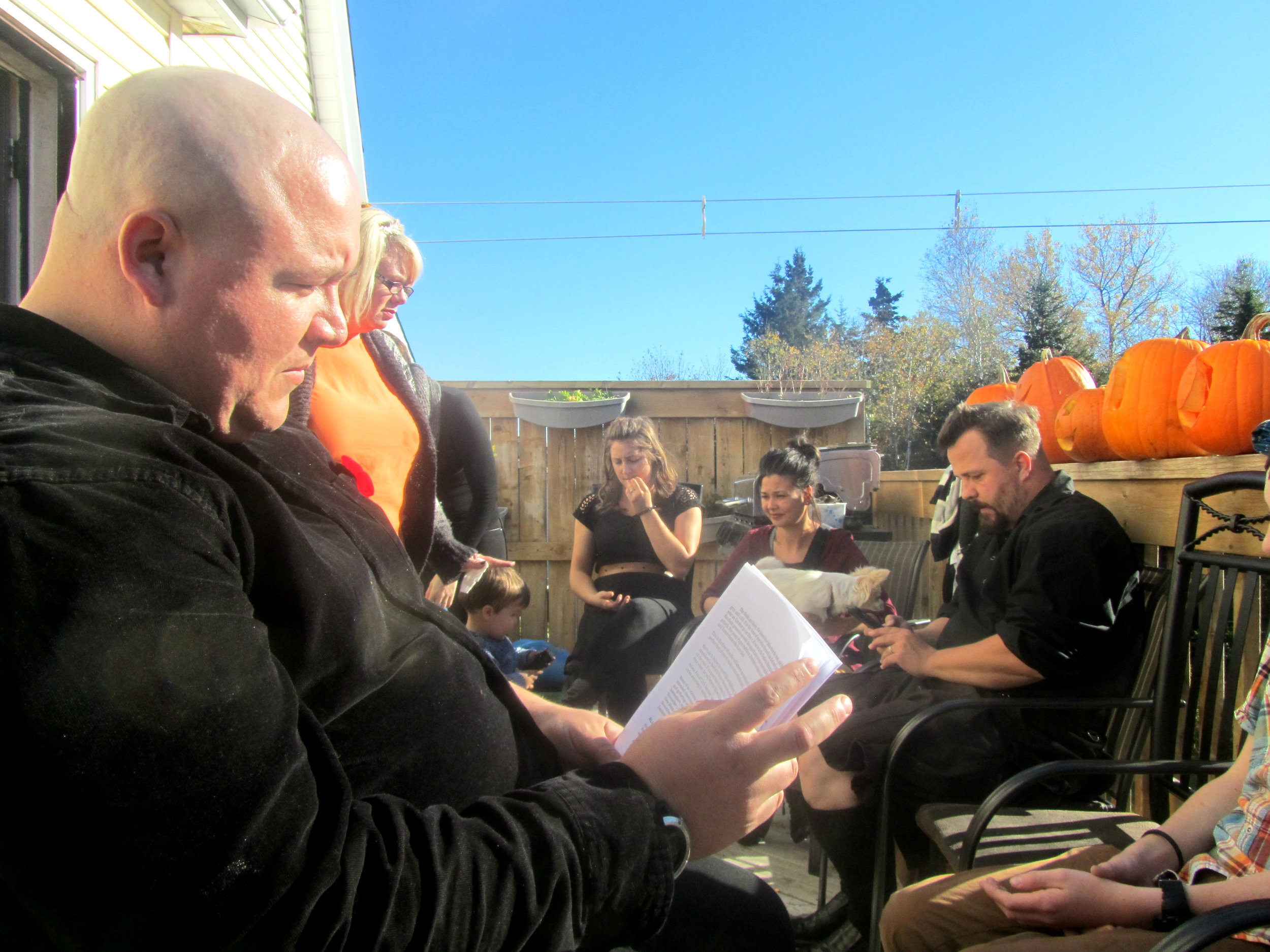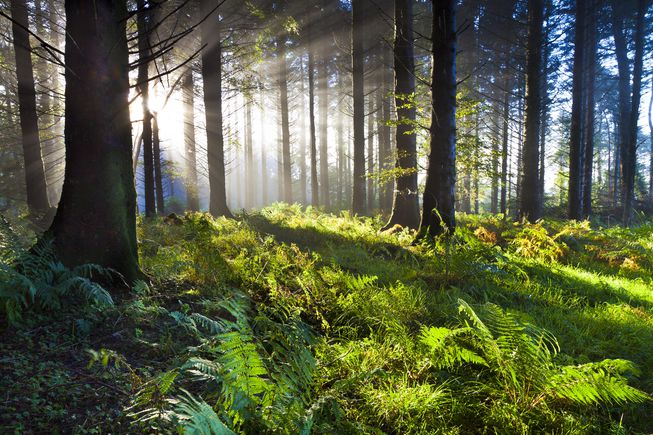
BLOG
Grove Cornucopia Painting Tutorial
So the grove has had a brown paper cornucopia kicking around for the past few fall equinoxes. The kind you can buy at craft shops sometimes. This year I took it upon myself to paint it to fancy it up a bit. I had a few bottles of acrylic paints, the kind you can find in dollar stores or craft stores. I think I got them at Michael's and Dollarama. I started by using a base coat of grass green all over the outside. Added a highlight of orange spice on the tops of the ridges. Blended between the two with olive green and highlighted with spun gold trailed over the olive to just add a glimmer of metallic to contrast the matte finish of the other colours. Turned out pretty snazzy. Now it's all ready for the next harvest season.
The Breaking of the Stick
Over the years I had seen a new tradition sort of creep up through the druid communities online and it piqued my interest. I had asked a fellow Canadian Druid Chelly Couvrette where this tradition came from and she directed me to a blog by Earrach of Pitsburg, The book of Sassafras.
Over the years, you may have seen me posting pictures like this on my blog or Facebook and, although some of you already may know the significance of this custom, some of you may not. "Custom?"... Yes, "The Breaking of the Stick" - - "but why do that? - Is it an ancient practice?"
My old article "The Power of the Impending Moment" sums up most of the idea here and introduces you to the tradition of the breaking of the stick at the sacred moment of the unique Earth/Sun relationship we pass through on every solstice and equinox. My idea of its core principle, the Sanctity/Veneration Feedback Loop, shows up in that article as well and in detail more recently in a post on this blog in November 2016.
"Ancient?" Although I first started this tradition in my own personal practice in the 1980's and incorporated it into my Grove Work in the 90's, I am not aware of a historical precedent for this ritualized action. This I'll assume is most possibly due to the fact that it was only recently that we have pocket timepieces that could with certainty mark a moment within the seconds of the minute of one's special moment de jour. I used to use the shortwave radio time signals from WWV at the Bureau of Standards in Ft.Collins CO - but nowadays, the times shown on anyone's cell-phone are reliably accurate to deep-down within the fractions of one single second. Yes, being within The Seconds of The Minute of the sacred event itself... that's what makes it especially powerful for me and the others who have adopted it or practices similar to it.
Yes, there it is, the imprint of the Sacred Moment, preserved in the broken ends of the stick, and clothed with all the import of that moment.
Its utility in your Rites of the Wheel? As is often the case, if your public rite is not held on the true day of the solstice or equinox, bringing the Broken Stick (wrapped/enshrined) to the rite and announcing its principle and importance before revealing it at the right moment, and then in the reception of the blessings, dipping the broken ends together into the Grail of the rite and using the wet ends to individually bless the Folk, that type of operation can potently bring Sacred Time and its spiritual inferences right down to a very personal level in our rites.
So, as it is that I've been doing this four times a year since the 1980's, yes, I've accumulated A Lot of Broken Sticks. In all that time I never have gotten around to doing the one cool thing I'd always mused on doing: binding the sets of sticks together on a wooden wheel or grapevine wreath to represent at least one whole solar cycle of The Wheel. Inevitably the new ones shove the older ones out of centrality on my shrine/altars - and, even with my fitful attempts to tag them, I've been consistently inconsistent to the point where I've not yet tagged and stored even one set of four to make a wheel. Yet I do treat the old ones with reverence and I have long had a special repository for them though: my Kiste ("Sacred Basket") of the Mysteries. Below you see me offering them from it into the Brushwood Nemeton Fire during my ordination to the ADF Druid Priesthood in May of 2002...
"Now all the knowledge of the heavens
pertinent to agriculture, standeth principally
upon three sorts of observations, to wit,
the rising of the fixed stars;
the setting of the same:
and the four cardinal points, to wit, of
the two tropics or sunsteads*,
and the double aequinox,
which divide the whole year into
foure quarters and notable seasons..."
Pliny the Elder (bk. xviii, chapter 25)
* Sunsteads: the December and June solstices
The Five Fairy Mounds of Nova Scotia
From the Dark Ages on, people have talked about fairy mounds. The home of the elusive sidhe (although people today call the fairy people sidhe, they used to be called aos si, and their sithen used to be sidh). These mounds or sithens are the dwelling place of the fairies of old. You know the legends of these mounds in the British Isles, but did you know that prior to the arrival of the Europeans to Nova Scotia, there were FIVE fairy mounds in Nova Scotia? In an earlier post, I talked about the fairy mound that was at the sight of current Inverness, Nova Scotia. The town was literally built atop it. But there were five in total. Also, interestingly enough, they are widely spaced across the map.
While the first mound was at Inverness, the second mound was within Dartmouth. Its exact location a mystery, only that the city built atop it. The third one was near the Wilkie Sugar Loaf Mountain in Cape Breton. The fourth one was located in the Dagger Woods area in Antigonish county. The fifth and last one was in the Kejimkujik Lake area. This last one is fairly interesting as the common belief held that it wasn't fairies, but rather pixies that lived there (pixies being much smaller than fairies, but pixies and fairies are also enemies). The Kejimkujik mound was closely studied by a famous Nova Scotia historian and author William Richard Bird.
The Dagger Woods mound in Antigonish was the sight of an abduction. A young married man, on his way home from a local "drinking establish" was captured and held for three days only to be released on the fourth. His wife was suspicious that he was spending his time with a former paramour, but under repeated questioning, he told his family and friends that he had no memory of the event. No memory at all.
These mounds and the people therein were well known to the Mi'mkaq people of Nova Scotia. They called them Mikmwesuk and believed them to have magical powers. Mi'mkaq people generally avoided these areas as the Mikmwesuk was said to be fond of playing tricks on people. Although they do also tell stories of people that were aided by the "little people" as well. Does that not sound familiar? Like the fairies of Europe?
The existence of these mounds has been documented in several books, long out of print. The question that remains is just what happened to the mounds? Are they still there? Have they been vacated? Or do the fairies/pixies still appear from time to time, leaving mischief in their wake?
Story from https://www.facebook.com/nscryptids/
Alter Décor and Expression
There isn’t really a way to do this right or wrong. There are standards…
Well to the East
Fire to the South
Tree to the West
But apart from that, ADF Druids (and the like) usually decorate their alters in ways that makes them feel connected, happy and spiritual.
You can use seasonal herbs and flora or candles and crafts. Most people incorporate symbols or effigies, but I will tell you my family alter is often quite simple and apart from the well, fire and tree I usually end up decorating it with things I’ve made. I mean, you always want beautiful flowers around Ostara but here in Nova Scotia you would be hard pressed to find the ground though all the snow let along a flower! I tend to make paper flowers ( I love papercraft and I build with intent), we have homemade candles and herbs that we often grew in our yard at some point.
Your alter need not be complex or garish unless you wish it so. Use what represents you and your deities.
If you are looking for inspiration, here are a few ideas:
Statuary
Precious books
Crystals
Ogham
Runes
Your well, fire and tree representations
Incense and holder
Candles
A tablecloth
Herbs
Flowers
Magical tools of any kind
Your chalice
Your offering bowl, plain or otherwise
Homemade (or lovingly made) crafts
Seasonally appropriate colours or figures (eg: reds and browns for Mabon etc.)
This is a very personal process and you should always do what resonates with you and your needs at the time. Be sure to cleanse whatever you place on your alter and always focus your intent as best you can.
Blessed be and happy decorating.
Karen
Cernunnos
A deity of Celtic Mythology and The Grove of Nova Scotia Druids’ patron deity. His name is a translation from various Celtic languages that means “horned one”. He is often depicted as man-like with antlers and hooves. He typically wears a torque (also spelled torc or torq), a semi- circular piece of jewelry often seen throughout Celtic history as a symbol of protection. He is accompanied by a stag, bull, snake or ram. Though his origins can be traced though many cultures he seems to originate in Celtic Mythology with the earliest depictions of him found in Northern Italy in an area which was under Celtic occupation around 400 BC. He is the protector of animals, the lord of animals. A representation of the wild; fertility; life and death and many important lessons that guide us today.
As with most things in Druid culture, the Horned God’s story follows the seasons with the Fall representing his Death, where he lies dormant during the Autumn and Winter and the Spring representing his resurrection where he would impregnate the Mother Goddess which gives wake to all life once again throughout the warmer and summer months. This circular story is thought to be a product of Neo-Paganism and it is believed that earlier celebrations of Cernunnos would have likely been dressing up as the God by adorning animal skins and trying to commune closely with him. Be that as it may, the Animal Lord has always represented Masculine Energy.
Cernunnos is an important part of our culture. He is said to have moved in such a surreal fashion that he was able to walk between the veils (between the land of the living and that of the dead) and he would guide the fallen to pursue a life of happiness and wisdom. He is seen as a prosperous, shielding God. There are stories of Cernunnos being associated with The Winter Stag where he would appear December 21st to those who received gifts and encourage them to give them to the less fortunate.
Unfortunately, as with much of the Pagan culture under which Druidry falls, much of the information supporting this writing is somewhat speculative and pieced together as strong efforts were made by the Christian church to eradicate Pagan Religion. Cernunnos was compared to Satan who at the time was portrayed as having great horns and this lead to families and Groves hiding their effigies and practices.
Yule Ritual
We had a lovely Yule Ritual last weekend and I am happy to be getting this post up before the 21st.
We did ritual, exchanged gifts and enjoyed making hearth protection charms.
Using wooden spoons (a sign of the hearth and common protection symbol) we carefully wrapped them in ribbon while contemplating peace, love and protection along with a couple spare giggles. We said a simple blessing “ Lend us bright blessings on this Yuletide fare, give us love and peace in equal share. With Yuletide warmth our hearths be blessed that lifts the heart of Kin and Guest”. We all took our spoons home and hung them in an appropriate place in the kitchen.
Blessed Yule everyone!
Hiking & Sage Harvesting
HEY! Remember when I wrote that blog about Harvesting Sage in September and how to make your own sage bundles? (No — Here, I will help: http://novascotiadruid.com/?p=864) Either way, we finally got to do it as a grove.
It was a fantastic day where we did a little hike in a local park and then we all came back to the Larter house to pick, bundle and tie up our very own sage bundles. We also had BBQ and someone was nice enough to bring clay for some bowl and goddess making which I will totally have to revisit another time.
Needless to say this was a resounding success. Everyone enjoyed themselves. We all got a little exercise; some time to commune with nature and we enjoyed the companionship of our amazing grovies.
I would encourage you to push for things like this with your own groups. I have been on a week long high from spending time with people who warm my heart and doing this that enrich my soul.
P.S. For your viewing pleasure, I tried to take a selfie…
Beltane with the Family
Fertility and sexuality are natural parts of life. There are few times in the druid calendar that would traditionally better suited to celebrate one’s sexuality than Beltane. Once upon a time, this might be celebrated with couples enjoying a good dance around the May Pole and even a bit of coupling in the Forests. But as natural as this is, it is not for everyone, particularly those with young children who are not yet ready for the complex topic of human sexuality in its many facets.
Don’t worry momma, you can still go a-May-ing during naps…;)
Beltane offers us many types of fertility to celebrate. Notably is the return of all things green and beautiful after the long cold winter. Let’s look at a few “ family friendly” ways to celebrate this turn of the wheel.
1. Making flower baskets or crowns to wear and share. This is a fantastic opportunity to teach your children about respecting and appreciating nature. It is also a fantastic crafting session where they will learn to work with their hands and build something beautiful. They can either keep their creation or share it to brighten someone’s day.
2. As always, and for all Druid celebrations I would encourage you to get outside. Have a nice walk and maybe bring a journal to jot down or draw all of the new life you see emerging around you. Take turns identifying the flowers and trees. This is another great learning opportunity for all.
3. Beltane tea party is a great opportunity for children to celebrate. Your children may not be ready to view prolific drinking or blatant adult content but there is no reason they can’t join in to celebration.. Why not host a beautiful Beltane Tea? Use bright colours and fresh flowers to decorate your table and enjoy a little bit of nature inside or out with some sweets and tea. Don’t forget to share with the faerie folk, they love treats.
4. If your children are a bit older and you are comfortable having them around fire why not stoke a Bale Fire. You can discuss the turning of the wheel while making s’mores and enjoying the fresh night air. (Just be sure to check burning restrictions in your area)
5. Beltane is a wonderful time to set out goals. Have your family write down and place their goals in a box and kept secret until the next year when you can revisit those goals and celebrate or reestablish your plan. Encourage anyone who wants to discuss to share and be supportive of their desires to grow like the new spring flowers. Your family is your greatest asset and can be an amazing source of support if you all practice.
These are just a few idea, but there are many more things you can do with your family.
Don’t be afraid to discuss sexuality once you feel the time is right. There are many resources online and in books to help with this difficult topic ones you and your child are ready.
Best of luck to you all and Blessed Beltane


